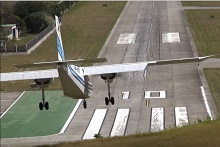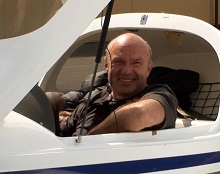An extreme airport: Madeira. Beware of turbulence on the runway
14.9.2017
Extreme airports I.: Madeira, Portugal Dear readers, Flying Revue owns one of the world's largest collections of landings at about 400 airports in Europe, the USA, Australia, and Africa. We have captured many of them on video, too. We chose the most demanding landings from a pilot standpoint, and we’d like to present these to you in our series of Extreme Airport articles. Here, in the first episode, we invite you to Funchal airport in Madeira as experienced by our pilot Jiri Prusa.
Madeira
Airport specifics
The Madeira airport's problem lies in the high cliffs to the north of runway 05/23 and the wind that often blows over them. The northern wind breaks off the cliffs and creates aggressive turbulences right above the runway. Landing at this airport becomes very difficult and even dangerous at times when there is a strong wind current.
Funchal Airport, Madeira - TOP 10 extreme airports Flying Revue
That makes it often impossible even for commercial aircraft to land here and they are forced to divert to an alternate airport or return to their airport of origin. The problem a small aircraft face is that they do not have enough fuel to return since they’ve been already flying for 4 or 6 hours. Smaller airplanes are then only able to divert to Porto Santo airport, which is about 100 km or 30-40 min away; however, Avgas fuel is not available there.
Madeira, an extreme airport, part 1. Word of the pilot
Arrival
Preparation I did not focus on the Madeira flight separately; my preparation was part of a larger scale expedition to the islands of the Mediterranean Sea and the Canary Islands. My airplane was equipped with all that I use at sea crossings: a life jacket, a dinghy, a radio, a satellite phone, emergency food and water, a waterproof bag, etc. At the same time, my position was displayed on a web-based online map in 5-minute intervals.
Is a special license needed? There is no need for special licenses in Madeira as PPL is sufficient, but it is necessary to request a landing slot as it is required by Portuguese AIP.
Flight date April 2014
Wherefrom I flew from Tenerife Norte airport, which is about 2,5 hours away. However, the flight lasted about 4 hours as I first flew over the Isla del Palma to take pictures. Also, I encountered strong headwind.
Weather As I mentioned, there was northern wind, i.e. headwind, which is a common occurrence here in the Spring, according to the statistics. Although it was cloudy, the visibility was good, clouds were high at about 4,000 feet.

![]()
Funchal Airport, Madeira in the Atlantic. Photo by Flying Revue
Approach I had established communication with Funchal Approach about 100 km before I’d reach Madeira. There was only one airliner that landed before me since traffic is slow in Madeira in the Spring. I was instructed to use runway 05, that meant the northern wind blew from my left on final. I entered right downwind of runway 05. The rest was standard – right base, final. Due to low traffic, I was number 1 for landing.
The landing permission was easy to get, although there was a lot of correspondence prior to my departure to secure the slot. Even though I couldn’t land at agreed time due to the strong headwind, it was not a problem in view of the low traffic.
What to watch out for
Wind The main problem is the turbulence that occurs towards the end of runway 05. You may see it in the video I took while landing. I dealt with it by increasing my speed and using only little flaps which gave the aircraft more energy and made it less sensitive to the wind gusts.
Take-off from Madeira-Funchal airport is quite
easy, it is just a bit turbulent. I took off twice from here, as I
first left for an hour flyover of Madeira with my new friend
Dinarte whom I met here at the airport. My second take-off was when
I left for Benavente near Lisbon. Both take-offs went smoothly and
neither of the landings had any other problems either except the
side turbulent wind. 
![]()
Funchal Airport on the island of Madeira. Credit: Google Maps
Landing type I made two full stop landings in Madeira. I had planned to come back about a year later during my trip to the Azores, but there was a very strong wind blowing for several days at that time, and the waves reached about 5 meters high; even TAP planes were not allowed to land here and they could not even use Funchal as an alternate airport. So, I went to Morocco instead and the Azores remain on my to do list.
Tie down Handling is not mandatory in Madeira; hence I did not request it. There was however no place to tie my plane down as they are not equipped to tie down small aircraft. So, when I asked one of the people at the airport for some weights such as a bag or a bucket of sand or tires filled with concrete, he replied: "Do you not carry it with you?" I am still laughing in my head when I remember this question even now … They eventually found some weights for me and I tied the aircraft down. It was important due to the strong wind gusts…
Landing on first attempt? Yes.
Any actual danger while landing / take off? There was none.
What about emotions? Joy of accomplishment, of course.
What about bureaucracy? A bit of paperwork, but it was not extreme - a standard at Spanish/Portuguese transport airports of about 40 minutes of filling out papers.
Any issues with regards to communication with staff? No problems.
Interesting notes: I’ll remember the man with the weights for a long time!
Madeira airport’s ranking on private list TOP 10 J.P. Madeira is a standard airport when there is no northern wind. The wind becomes a problem though, so the order would need to be determined by the force of the wind. In my case, I landed in turbulent wind, but still within the limits of my plane, so I did not endure any increased danger. I have experienced landings at six of the TOP 10 airports, and I would rate Madeira airport as number 4 of 5.
Overall rating
First, to give an accurate rating, it is necessary to evaluate the wind. It takes about 5 or 6 hours of flight from the Portuguese mainland, and the weather can change many times during this time. It is therefore necessary to monitor the forecast, not just the current weather at take-off. It is easier to estimate the weather when flying from the Canary Islands as the flight is shorter, it only takes about 2,5 – 4 hours. Strength and direction of the wind during the actual flight are the most important factors when flying to and/or from Madeira. At about 10 000 feet above sea level, the wind speed of 40 km per hour is strong enough to extend the flight by about an hour.
Often you’d encounter wind speeds of 60-80 km per hour when flying above the sea. Headwind of this strength is too much for an airplane such as Dynamic WT9, or any other small plane that has a range of up to 7 hours. The rule is that you should have a fuel reserve of at least 30 minutes, preferably more, in case you’d have to attempt landing multiple times. When landing at windy airports such as Madeira, you will definitely need this fuel reserve. Therefore, the wind must be taken into consideration when planning your flight, and if the headwind turns out to be stronger than you thought, you can try to adjust the altitude; direction and speed of the wind are different at various altitudes. If change of altitude does not help it may be better to return to your origin or divert to an alternate airport before reaching a point of no return.
Plans to land at Madeira in the future? Absolutely, I’d love to return to Madeira at least once, preferably twice, on my way to and from the Azores.
Jiri Prusa, Jan Dvorak



The SAFE Guide app
VFR Communication
ATTEMPT TO FLY 3000 km WITHOUT LANDING
SkyDemon:
Prague Airport live:
























